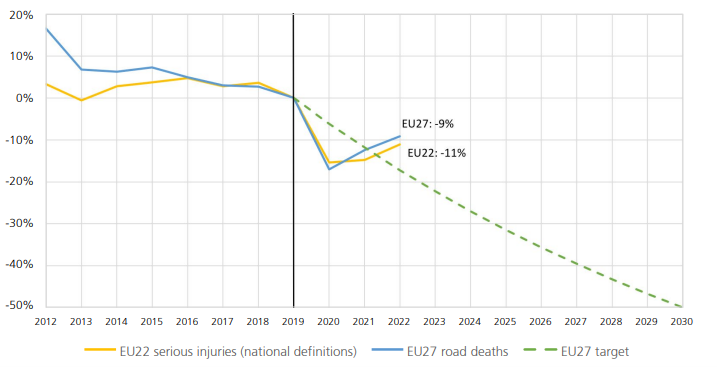2.3 The paradigm shift to Safe System
Progressive shifts in road safety thinking and practice have taken place since the middle of the last century. As outlined briefly in Chapter 1. Scope of the Road Safety Problem , an increasingly ambitious approach has been identified, which has culminated in the Safe System goal of eliminating road crash deaths and serious injuries (Peden et al., 2004; ITF, 2008; Bliss & Breen, 2009).
In the 1950s and 1960s, rapid motorisation took place in many OECD countries, accompanied by increasing numbers of road deaths and serious injuries. At that time, the emphasis in policymaking was on the driver. Legislative rules and penalties were established, supported by information and publicity, and subsequent changes in behaviour were expected. As experience has shown, it was wrongly believed that since human error contributed most to crash causation, educating and training road users to behave better could address the road safety problem effectively.
Systems approach to intervention
During the 1970s and 1980s, a systems perspective on interventions was evident. William Haddon, an American epidemiologist, developed a systematic framework for road safety based on a disease model that comprised infrastructure, vehicles and users in pre-crash, in-crash and post-crash stages (Haddon, 1968). Central to this approach was the understanding that the exchange of kinetic energy in a crash leads to injury, which needs to be managed to ensure that the thresholds of human tolerances to injury are not exceeded. This broadened the scope of intervention to highlight the need for system-wide delivery.
System-wide interventions, targeted results and institutional leadership
By the early 1990s, countries achieving good results had progressed towards implementing action plans with quantitative targets to reduce death and sometimes serious injuries (OECD, 1994; ITF, 2008; PIARC, 2012). The reductions achieved in different groupings of EU countries are presented in Figure 2.2.

Between 2012 and 2022, the EU27 as a whole decreased traffic fatalities by 22%. In 2022, 20,678 people died on EU roads. In the last decade there have been 39,554 fewer deaths than there would have been deaths had continued at the same level as in 2012 (ETSC, 2023).
In many countries, casualty reductions have been achieved through system-wide intervention packages. Typically, four broad categories of interventions were responsible for the majority of safety gains achieved. These are:
- Enforcement of key road safety behaviours (e.g. speed, alcohol, seatbelts and child restraints, helmets, fatigue).
- Safety engineering of road environments.
- Vehicle safety improvements.
- Improvements in the emergency medical system and road trauma care.
Safe System goal and strategy and shared responsibility
By the late 1990s, two of the world’s best performing countries had determined that maintaining continuous improvement in performance would require a more ambitious, comprehensive and sustainable approach than had been adopted in previous practice. The Dutch Sustainable Safety and Swedish Vision Zero strategies aimed to make the road system intrinsically safe (Koornstra et al., 1992; Tingvall, 1995; Wegman & Elsenaar, 1997).
In both the Sustainable Safety and Vision Zero approaches, new emphasis is given to managing the exchange of kinetic energy in a crash to ensure that the thresholds of human tolerances to injury are not exceeded. Road deaths and serious injuries are no longer seen as a necessary price to be paid for improved mobility (Tingvall & Haworth, 1999).
The Safe System approach goes further than traditional approaches that focused on safer vehicles, safer roads and safer users. This newer approach now also addresses the critical interfaces between them. The ‘engineered’ elements of the system, i.e. vehicles and roads, can be designed to be compatible with the human element, recognising that while crashes might occur, the total system can be designed to minimise harm (Tingvall, 1995; Ydenius, 2010). This shared responsibility for better design is a key element of the Safe System approach.
In a sustainably safe road traffic system, infrastructure design inherently and drastically reduces crash risk. Should a crash occur, the process that determines crash severity is conditioned in such a way that severe injury is almost excluded.
Towards sustainably safe road traffic (Koornstra et al., 1992)
BOX 2.8: RELEVANCE OF THE SAFE SYSTEM APPROACH TO LMICS
The Safe System approach:
- Addresses all elements of the road traffic system in an integrated way
- Emphasises the reduction of death and long-term injury rather than the prevention of crashes
- Challenges the fatalistic view aptly termed ‘the scandal of tolerance’ (Allsop, 2002) that states that road traffic injury is the price to be paid for achieving mobility and economic development. This is done by setting a societal goal with step-wise targets to eliminate road deaths and serious injuries in the long-term
- Accentuates the shared and accountable responsibility of designers and users of the road network for achieving road safety results
- Addresses limitations in human capacities in the setting of safety standards and rules; and related compliance regimes for the planning, design and use of the road network; the conditions of entry and exit of vehicles and road users to the road network; and the recovery and rehabilitation of crash victims from the road network
- Demands equity in addressing the safety needs of both motorised and non-motorised users
- Aligns well with the goals of sustainable development and presents opportunities for achieving co- benefits with other societal objectives
- Necessitates the strengthening of all elements of the road safety management system, especially institutional management functions, to achieve sustainable success.
Source: Bliss & Breen, 2012; ITF, 2008
In-depth discussion of the Safe System approach, its scientific basis and scope is set out in Chapter 4. Safe System Approach. An introduction to steps to implementing Safe System projects in low-income countries are set out in Institutional Management Functions in Section 3.2. Management System Framework and Tools and discussed more fully in Chapter 4. Safe System Approach and Chapter 6. Targets and Strategic Plans.






